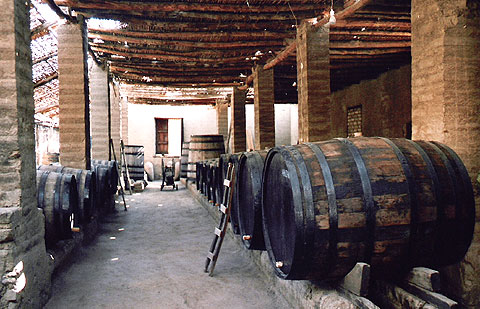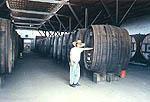About Ica
Ica is known as an area of desert, sand dunes, oases and valleys, the birthplace of Creole art of Peru, blessed people and witches, where the best pisco brandy is distilled and where religious fervor is strong in the worship of the Señor de Luren or the Yauca shrine. The sandy wastes of this area gave rise to major pre-Colombian civilizations, leaving traces that have survived the ravages of time and wind erosion.
The territory of Ica was inhabited by great pre- Inca civilizations as Chincha, Nazca and Paracas cultures.
Ica city was founded in 1536 by the Spaniard Jerónimo de Cabrera. He gave the name of "Villa de Valverde". The city was in the middle of a fertile valley. Before its foundation, the Spaniards planted grapes brought from Canary Islands (Spain) and then began the tradition of the wine and the pisco.
Ica was the first city in "Nueva Castilla" (Peru in the Viceroyalty times) where wine and grape liquor were produced, and from this point they were exported to all the Spanish colonies in America. They used the port of Pisco to embark the grape liquor, giving origin to the name of one of the most famous liquors prepared in Peru, Pisco.
Also Ica is the name of the department, and has 4 provinces: Ica, Pisco, Nazca, Chincha and Palpa.
The highway from Lima to Ica provides the traveler with a variety of attractions. First stop along the way is Chincha, a balmy valley that combines festivals and tradition and which is the heart of a culture forged by the descendants of African slaves brought to work the cotton plantations. The next point is the Paracas National Reserve, the only protected area in Peru that includes a marine ecosystem. From Ica city you can take an over flight to Nazca Lines.
Ica City Overview
-
Location:
Central coast, 406 meters above sea level (1,332 feet)
-
Distances to Ica:
-
Population:
321,000 inhabitants
Ica Guide
Ica, the city of eternal sunshine, nowadays the city continues being a very pleasant one, among sand deserts and huarangos (carob tree) and with a wonderful sunny weather. Ica is recommended as a start point to visit the Nazca Lines and the Paracas National Reserve, both declared as World Heritage Sites by UNESCO.
Huacachina Oasis: This beautiful oasis is located at 5 Km southwest from Ica city, place in the desert with a small lagoon and is surrounded by sand dunes, palms, huarangos (carob tree) and beautiful houses around the shore. By the ends of the XIX century Huacachina was practically uninhabited, until the Italian Angela Perotti rediscovered the medical properties of water and mud of the lagoon, specially for the cure of skin and rheumatism illnesses. You may find comfortable hotels and cheap lodges, restaurants and discos that will make your trip enjoyable, ideal place for relax or for the desert adventures. Buggies and sandboarding has become popular on the sand dunes near Huacachina, an ideal area to take to the steep sandy slopes of the desert.
Adolfo Bermúdez Jenkins Regional Museum
Location: Avenida Ayabaca, block 8. Visiting Hours: Mon. – Fri. 8:00 A.M. – 7:00 P.M. Sat. and holidays 9:00 A.M. to 6:00 P.M. Sun. 9:00 A.M. – 1:30 P.M. It has a big collection of archaeological pieces from the regional cultures Nazca, Paracas and Inca. Out stand funeral mummies and looms from Paracas, skulls with presence of surgery and deformed skulls, this remains show the high technology in surgery reached by the ancient Peruvian civilizations. It also has collections from the colony, independence and republican times.
Marquis of Torre Hermosa House
Location: Calle Libertad, block 1, Main Square. It is one of the few examples of Vice-royal architecture that has survived earthquakes and urban growth. It possesses an exquisite Rococo façade worked in stone. It is also known as the Casa Bolívar since it lodged the Liberator during his stay in this city.
Iglesia de Luren: Location corner of Piura and Ayacucho streets. This religious sanctuary contains the venerated image of "Señor de Luren", the one that was redeem from a shipwreck in 1570 in front of the coasts of Ica, coming from Spain. Señor de Luren patron of Ica, congregates each year thousands of pilgrims during the Holy Week and the third Monday of October in traditional processions. Devote people attribute miracles to the Lord. The catholic devotion in Ica also has expressions of pilgrimage to the Sanctuary of Yauca, where the image of the Virgin of Yauca is venerated. Also venerated the "Beatita de Humay" and the "Melchorita" in the towns of Humay and Grocio Prado.
Cachiche: Famous village located at 4 Km of Ica, it is well known because of the witches that cure illnesses from popular believes. If you visit Cachiche do not forget to see the statue of a witch laid on a Huarango tree. This circuit features the best of Peru's Afro-Peruvian culture, where one can savor distilled aguardiente and fermented grape musts which are typical of the area. There are also interesting pre-Hispanic archaeological sites in the area.
Wineries and Pisco Cellars: Ica is very famous because of its pisco (grape liquor) and wine; a good alternative for your trip could be a visit to the pisco cellars and bodegas (wineries) of La Caravedo, Vista Alegre, Tacama, Ocucaje and the artisan ones located in the suburb of Guadalupe. In these places you will be able to learn about the elaboration of pisco and the wine in the traditional way using distillers made during the Colonial time.
-
Tacama Vineyard: 7 Km (4 miles) northeast of Ica (45 minutes). Visiting hours: Mon. – Sun. 9:00 A.M. – 5:00 P.M. It is dedicated to the elaboration of wine and pisco. It was owned by the Jesuits during Colonial times, and the mansion and the old stables of the epoch still remain.
-
Bodega Vista Alegre: 3 Km (2 miles) northeast of Ica (10 minutes). Visiting hours: Mon. – Fri. 9:00 A.M. – 4:00 P.M., Sat. – Sun. 9:00 A.M. – 5:00 P.M. A traditional bodega dedicated to the elaboration of wine and pisco, it still maintains characteristics of Colonial practices of grape processing.
-
Bodega Ocucaje: Avenida Principal. 34 Km (21 miles) southwest of Ica (45 minutes). Visiting hours: Mon. – Fri. 9:00 A.M. – 12:00 P.M. and 2:00 P.M. – 5:00 P.M. Sat. 9:00 A.M. – 12:00 P.M. The bodega demonstrates long used traditional techniques of the department for the production of pisco and wine.
La Vendimia (The Grape Harvest Festival): This festival in March, is a celebration of the abundance of grapes and wine in the region of Ica, where persevering efforts in local vineyards have spread greenery across vast tracts of once bone-dry desert. The Wine Festival involves fairs, competitions, processions of floats, musical festivals and parties where guests dance the Afro-Peruvian festejo. One of the major attractions of the event is the Queen of the Wine Festival beauty pageant. Accompanied by her hand-maidens, the beauty queen treads grapes in a vat in the time-honored tradition to extract the juice that will eventually be fermented. Apart from the delicious local sweets known as tejas, made from pecans or candied fruits, filled with caramel and covered with sugar icing, those attending the event can free flowing wine and pisco the aromatic and tasty grape brandy that originated in this part of southern Peru four centuries ago.
The Afro-Peruvian folklore is an essential contribution from Ica, and it is expressed in its lilting rhythms, the cheerfulness of its people and its gastronomy.
Some tour operators stay in hotels of Ica to visit Nazca Lines and Paracas tours.













